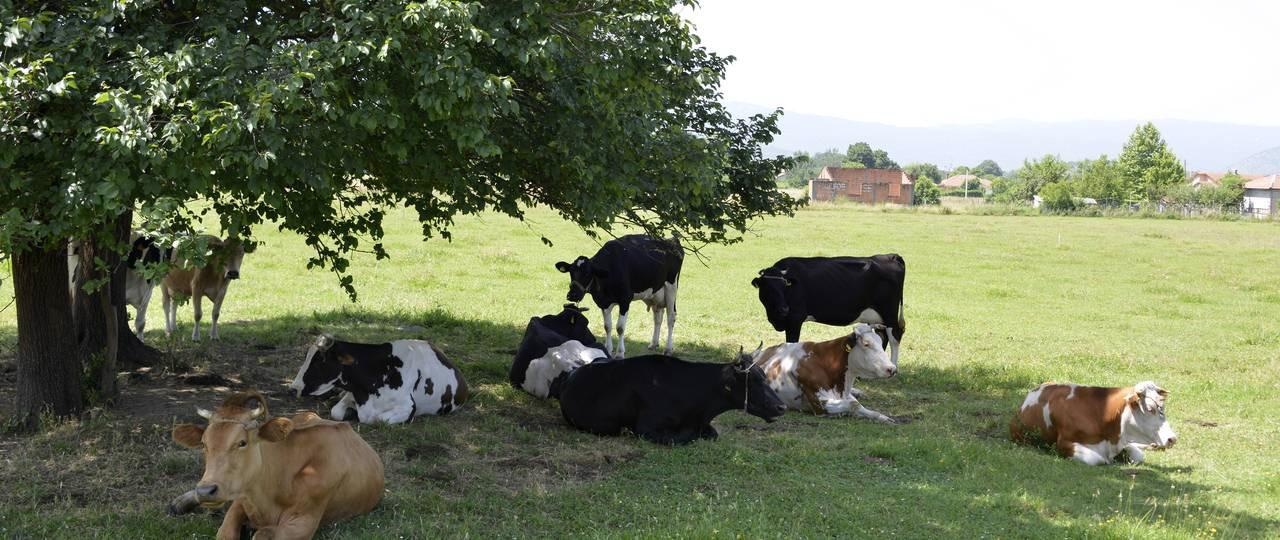The occurrence of frequent extreme heat and stable high temperatures for long periods tend to cause an increase in psychological stress in humans, animals and crops, which is currently a cause of concern in Canada and the American Northwest.
 Particularly during the summer months, some livestock are raised outside. Dairy cows have severe dehydration when 12 percent of their body weight has been lost as water. Increased natural shading by trees is one adaptation strategy to rising temperatures in the livestock sector. Image Credit: iStockphoto.com/Magdevski.
Particularly during the summer months, some livestock are raised outside. Dairy cows have severe dehydration when 12 percent of their body weight has been lost as water. Increased natural shading by trees is one adaptation strategy to rising temperatures in the livestock sector. Image Credit: iStockphoto.com/Magdevski.
Prof. Senthold Asseng, director of the World Agricultural Systems Center at the Technical University of Munich (TUM), gives an insight into thresholds and adaptation strategies.
We have studied which temperatures are preferable and which are harmful in humans, cattle, pigs, poultry, and agricultural crops and found that they are surprisingly similar.
Senthold Asseng, Professor of Digital Agriculture, Technical University of Munich
The study reports that suitable temperatures vary from 17 °C to 24 °C.
When does it become too hot for humans?
When the humidity is high, mild heat strain for humans starts at about 23 °C and low humidity starts at 27 °C.
If people are exposed to temperatures above 32 degrees Celsius at extremely high humidity or above 45 degrees Celsius at extremely low humidity for a lengthy period of time, it can be fatal. During extreme heat events with temperatures far above 40 degrees Celsius, such as those currently being observed on the U.S North West Coast and in Canada, people require technical support, for example in the form of air-conditioned spaces.
Senthold Asseng, Professor of Digital Agriculture, Technical University of Munich
To overcome the increase in heat strain, Prof. Asseng suggests several approaches, which include improving the natural shade from trees or structural shading. Cities and buildings can be modified to become more temperature-passive, for instance, roof and wall insulations, as well as lighter reflective roof and wall colors, can be used to reduce heat strain.
How do high temperatures affect livestock?
Cattle and pigs suffer heat strain at 24 °C with high humidity and 29 °C with low humidity. Exposure to heat stress can cause a 10% to 20% reduction in the milk yield from cows, as well as a decrease in the fattening factor of pigs. Poultry can sustain comfortably at 15 to 20 °C. Chickens would experience mild heat strain at 30 °C. When the temperature crosses 37 °C, they experience acute heat stress, resulting in lower egg-laying capacity.
Generally, heat stress reduces the growth rate of dairy cows, chickens, pigs and other livestock, which implies both their yield and reproductive performance decline.
There are examples of evolutionary adaptations to warm weather in terrestrial mammals. Transylvanian naked chickens are more heat tolerant than other varieties of chickens because of a complex genetic mutation that suppresses feather growth. They are naturally air-conditioned because they lack feathers on their necks.
Senthold Asseng, Professor of Digital Agriculture, Technical University of Munich
How do crops react to high temperatures?
“In crops, the optimal temperature zone and temperature thresholds seem to be more diverse due to differences between species and varieties,” explained Prof. Asseng.
Cold-temperate crops like wheat perform better at cooler temperatures, while warm-temperate crops like corn are sensitive to frost but can tolerate warmer temperatures. Heat stress reduction approaches in crop production include alteration of the planting dates to prevent heat stress later in the season, switching to more heat-resistant crops, irrigation (if viable) and breeding to improve heat tolerance.
How is climate change affecting life on Earth?
“By the end of the century, 45 to 70 percent of the global land area could be affected by climate conditions in which humans cannot survive without technological support, such as air conditioning. Currently, it's 12 percent,” stated Prof. Asseng.
This implies that in the coming years, 44% to 75% percent of the human population would experience acute heat stress. An analogous increase in heat stress has been predicted for livestock, poultry, agricultural crops and other living organisms.
“Genetic adaptation to a changing climate often takes many generations. The time available is too short for many higher forms of life. If current climate trends persist, many living things could be severely affected or even disappear completely from Earth due to temperature change,” concluded Prof. Asseng.
Journal Reference:
Asseng, S., et al. (2021) The upper temperature thresholds of life. The Lancet Planetary Health. doi.org/10.1016/S2542-5196(21)00079-6.